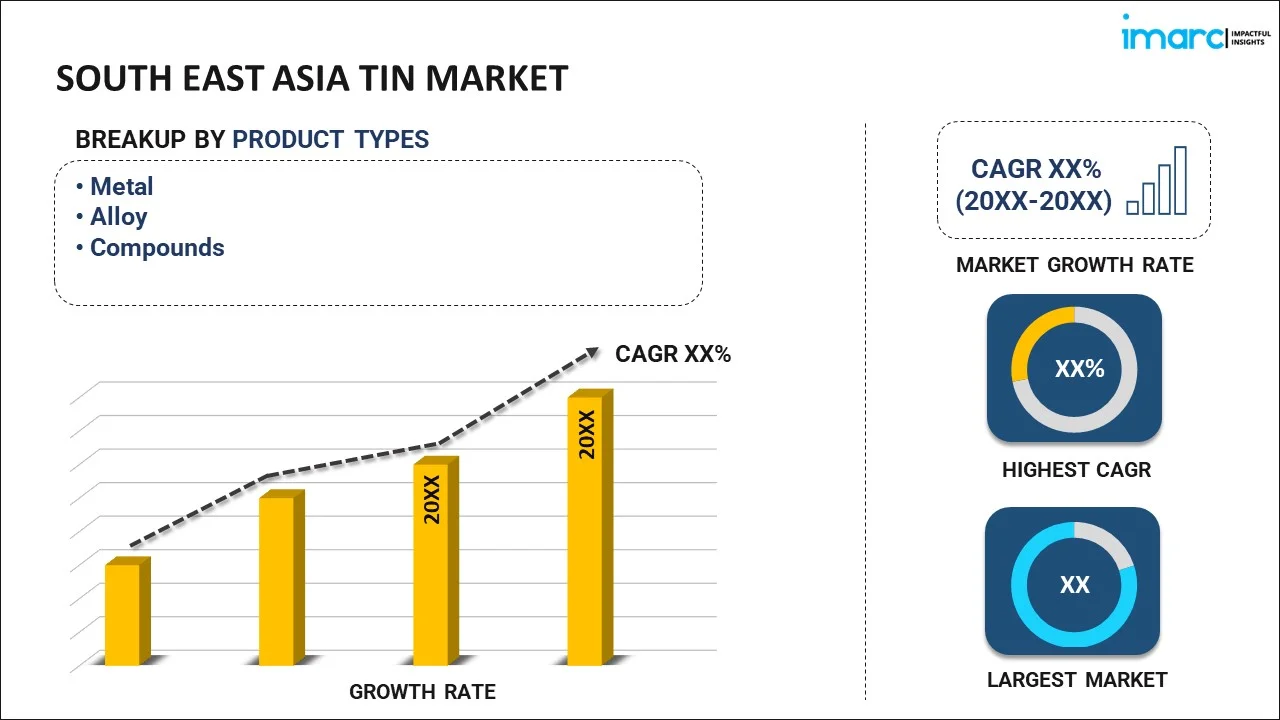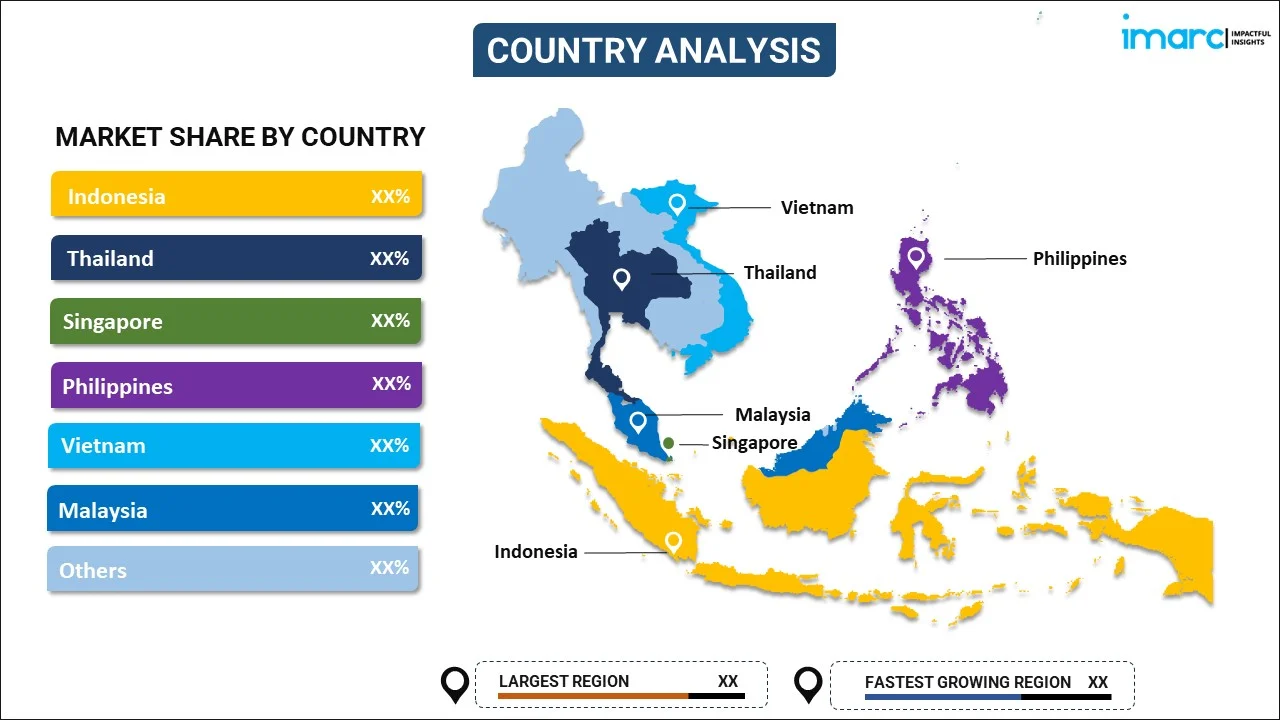
South East Asia Tin Market Report by Product Type (Metal, Alloy, Compounds), Application (Soldering, Tin Plating, Chemicals, and Others), End Use Industry (Automotive, Electronics, Packaging (Food and Beverages), Glass, and Others), and Country 2024-2032
Market Overview:
The South East Asia tin market size is projected to exhibit a growth rate (CAGR) of 2.79% during 2024-2032. The significant expansion of the electronics manufacturing sector to produce solder, the emerging technological advances in mining and extraction technologies, and the widespread adoption of tin in the automotive sector represent some of the key factors driving the market.
|
Report Attribute
|
Key Statistics
|
|---|---|
|
Base Year
|
2023 |
|
Forecast Years
|
2024-2032 |
|
Historical Years
|
2018-2023
|
| Market Growth Rate (2024-2032) | 2.79% |
Tin is a chemical element with the symbol Sn and atomic number 50. It is a silvery-white, malleable metal that has been used by humans for thousands of years. It is known for its versatile properties and several applications, making it an essential element in various industries. The most notable characteristic of tin is its low melting point, which makes tin easy to work with, and it has been widely used in the production of alloys, such as bronze, pewter, and solder. It can form alloys with other metals, enhancing its strength and durability making it a valuable component in the manufacturing of various products, from kitchen utensils to electrical components. It also has excellent corrosion resistance, making it suitable for coating other metals to protect them from rust and deterioration. For instance, tin plating, referred to as tinning, is a common practice in the food packaging industry, where tin-coated steel cans are used to preserve and store various food products. This protective layer of tin prevents the contents from meeting the steel, preventing contamination and ensuring the longevity of the packaged goods.
South East Asia Tin Market Trends:
The market is primarily driven by rapid industrialization across the region. In addition, the rising demand for tin, as it is an essential component in various industries, including electronics, packaging, and construction, influences the market growth. Also, tin's corrosion-resistant properties and its ability to be alloyed with other metals make it indispensable in these sectors, augmenting the market growth. Moreover, the significant expansion of the electronics manufacturing sector in the production of solder, which is used in the assembly of electronic circuits, represents another major growth-inducing factor. Along with this, several advances in mining and extraction technologies made it more cost-effective to extract tin from ore deposits, which increased the supply of tin and made it more accessible to meet the growing demand, which is accelerating the market growth. Besides this, the shift toward renewable energy sources, such as solar panels and wind turbines, led to the adoption of tin to produce photovoltaic cells for solar panels, propelling the market growth. Apart from this, several infrastructure development projects are creating a substantial demand for tin in the construction sector. Tin-coated steel is widely used in roofing materials and construction products due to its durability and resistance to corrosion. As countries in the region invest in infrastructure upgrades and new construction projects, the tin market benefits from this increased demand. Furthermore, the widespread adoption of tin in the automotive industry to manufacture various automotive components, such as bearings and coatings, is creating a positive market outlook.
South East Asia Tin Market Segmentation:
IMARC Group provides an analysis of the key trends in each segment of the market, along with forecasts at the regional and country levels for 2024-2032. Our report has categorized the market based on product type, application, and end use industry.
Product Type Insights:

- Metal
- Alloy
- Compounds
The report has provided a detailed breakup and analysis of the market based on the product type. This includes metal, alloy, and compounds.
Application Insights:
- Soldering
- Tin Plating
- Chemicals
- Others
A detailed breakup and analysis of the market based on the application have also been provided in the report. This includes soldering, tin plating, chemicals, and others.
End Use Industry Insights:
- Automotive
- Electronics
- Packaging (Food and Beverages)
- Glass
- Others
The report has provided a detailed breakup and analysis of the market based on the end use industry. This includes automotive, electronics, packaging (food and beverages), glass, and others.
Country Insights:

- Indonesia
- Thailand
- Singapore
- Philippines
- Vietnam
- Malaysia
- Others
The report has also provided a comprehensive analysis of all the major regional markets, which include Indonesia, Thailand, Singapore, Philippines, Vietnam, Malaysia, and Others.
Competitive Landscape:
The market research report has also provided a comprehensive analysis of the competitive landscape. Competitive analysis such as market structure, key player positioning, top winning strategies, competitive dashboard, and company evaluation quadrant has been covered in the report. Also, detailed profiles of all major companies have been provided.
South East Asia Tin Market Report Coverage:
| Report Features | Details |
|---|---|
| Base Year of the Analysis | 2023 |
| Historical Period | 2018-2023 |
| Forecast Period | 2024-2032 |
| Units | US$ Billion |
| Scope of the Report | Exploration of Historical Trends and Market Outlook, Industry Catalysts and Challenges, Segment-Wise Historical and Future Market Assessment:
|
| Product Types Covered | Metal, Alloy, Compounds |
| Applications Covered | Soldering, Tin Plating, Chemicals, Others |
| End Use Industries Covered | Automotive, Electronics, Packaging (Food and Beverages), Glass, Others |
| Countries Covered | Indonesia, Thailand, Singapore, Philippines, Vietnam, Malaysia, Others |
| Customization Scope | 10% Free Customization |
| Report Price and Purchase Option | Single User License: US$ 3699 Five User License: US$ 4699 Corporate License: US$ 5699 |
| Post-Sale Analyst Support | 10-12 Weeks |
| Delivery Format | PDF and Excel through Email (We can also provide the editable version of the report in PPT/Word format on special request) |
Key Questions Answered in This Report:
- How has the South East Asia tin market performed so far and how will it perform in the coming years?
- What has been the impact of COVID-19 on the South East Asia tin market?
- What is the breakup of the South East Asia tin market on the basis of product type?
- What is the breakup of the South East Asia tin market on the basis of application?
- What is the breakup of the South East Asia tin market on the basis of end use industry?
- What are the various stages in the value chain of the South East Asia tin market?
- What are the key driving factors and challenges in the South East Asia tin?
- What is the structure of the South East Asia tin market and who are the key players?
- What is the degree of competition in the South East Asia tin market?
Key Benefits for Stakeholders:
- IMARC’s industry report offers a comprehensive quantitative analysis of various market segments, historical and current market trends, market forecasts, and dynamics of the South East Asia tin market from 2018-2032.
- The research report provides the latest information on the market drivers, challenges, and opportunities in the South East Asia tin market.
- Porter's five forces analysis assist stakeholders in assessing the impact of new entrants, competitive rivalry, supplier power, buyer power, and the threat of substitution. It helps stakeholders to analyze the level of competition within the South East Asia tin industry and its attractiveness.
- Competitive landscape allows stakeholders to understand their competitive environment and provides an insight into the current positions of key players in the market.
Need more help?
- Speak to our experienced analysts for insights on the current market scenarios.
- Include additional segments and countries to customize the report as per your requirement.
- Gain an unparalleled competitive advantage in your domain by understanding how to utilize the report and positively impacting your operations and revenue.
- For further assistance, please connect with our analysts.
 Inquire Before Buying
Inquire Before Buying
 Speak to an Analyst
Speak to an Analyst
 Request Brochure
Request Brochure
 Request Customization
Request Customization




.webp)




.webp)












